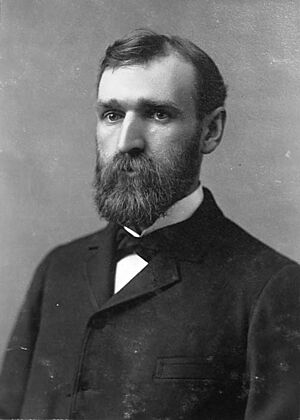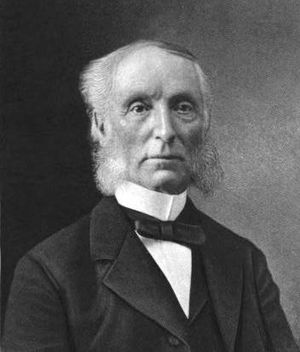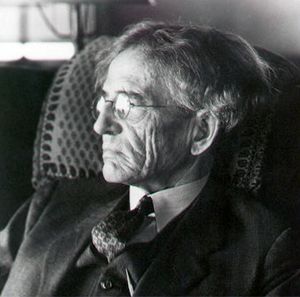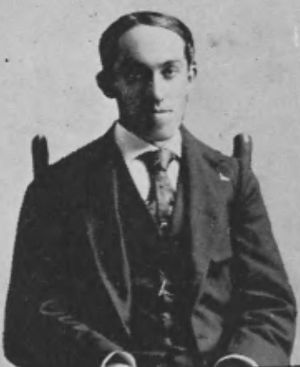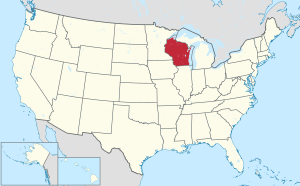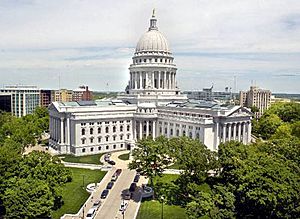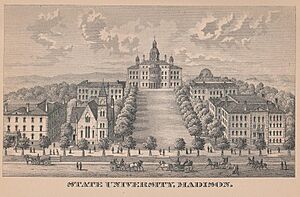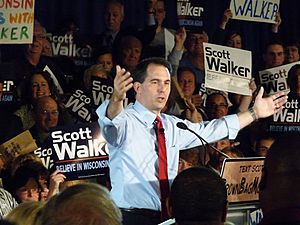Wisconsin Idea facts for kids
The Wisconsin Idea is a special way of thinking that has shaped how the U.S. state of Wisconsin handles its education and politics. It's about making sure that knowledge and good ideas from the state's university help everyone in Wisconsin.
In education, the Idea means the University of Wisconsin System should share its research and knowledge to solve problems and improve life for all citizens. In politics, it's linked to a time of big changes called the Progressive Era. During this time, Wisconsin became known for trying new ideas in government that helped ordinary people.
The Wisconsin Idea was first clearly stated in 1904 by Charles Van Hise, who was the president of the University of Wisconsin–Madison. He said he wouldn't be happy "until the good influence of the university reaches every family in the state." This meant the university should help the government by offering advice and information. It also meant helping citizens by doing research to solve important state problems and reaching out to communities.
In politics, the Idea was inspired by traditions that German Americans brought to Wisconsin. People who supported the Idea saw U.S. states as "laboratories for democracy" – places where new ideas could be tested. This led to many important changes. These included new ways to choose political candidates, help for injured workers, rules for transportation, and a fairer tax system where wealthier people pay a higher rate. These changes became examples for other states and even the national government. Today, the political side of the Idea is about making sure laws are well-made and help the most people.
Contents
Education and the Wisconsin Idea
For over 100 years, the University of Wisconsin System has followed the Wisconsin Idea. This idea was first explained by University of Wisconsin President Charles Van Hise in 1904. He famously said he wouldn't be happy "until the good influence of the university reaches every family in the state."
The Wisconsin Idea means that university research should be used to solve real-world problems. This includes improving health, daily life, the environment, and farming for everyone in the state. As Adlai Stevenson II once explained, the Wisconsin tradition meant believing in people. It also meant using smart thinking and facts to solve society's problems. It was about government using the best knowledge and understanding it could find to guide its way.
This policy from the Progressive Era used the university's knowledge to create laws that helped all citizens. It led to programs like regulating public services, workers' compensation, tax reform, and university outreach services. People often summed it up by saying, "the boundaries of the campus are the boundaries of the state." Over time, for the UW System, the Wisconsin Idea has come to mean the university's strong commitment to public service. This mission actually started long before the Progressive political era.
How the Idea Started
The University of Wisconsin–Madison was started in 1848, but the Wisconsin Idea wasn't part of its original plan. The idea grew slowly for about 50 years until the Progressive Era. During this time, Wisconsin became famous for its new ideas in economics and politics.
In this exciting period, the original "Wisconsin Idea" became popular. It was the idea that a public university should improve the lives of people far beyond its campus. Governor Robert M. La Follette, Sr. often asked University of Wisconsin researchers for help. They worked together to create new programs and laws.
Even though the Wisconsin Idea is often linked to Charles Van Hise's 1904 speech, many university leaders and teachers helped create it. David Hoeveler, a history professor, believes the Idea started even earlier. He thinks it came from the creative mind of John Bascom.
Bascom was a philosopher and teacher who greatly influenced students at the University of Wisconsin. These students included La Follette and Van Hise. Bascom used ideas from different fields to support social and political changes. He fought for things like temperance (avoiding alcohol), women's rights, and workers' rights. As university president from 1874 to 1887, his ideas sometimes caused disagreements. Bascom believed state governments and universities should play a bigger role in making society better.
John R. Commons is another important teacher who helped shape the Wisconsin Idea. He and Richard T. Ely believed that university researchers should be a key source of knowledge for the government and citizens.
The activities and ideas that make up the "Wisconsin Idea" weren't officially named until 1912. That's when Charles McCarthy described the philosophy in a book with that title. By then, Wisconsin was already known across the country for its new laws.
The University of Wisconsin System Today
Originally, the UW System schools outside Madison were teacher training schools. They grew over time, adding graduate programs. In 1971, there was a strong push to combine all the universities in the state into one system. With the help of Governor Patrick Lucey, the Wisconsin State Universities and the University of Wisconsin (Madison) joined together. This kept each campus's unique focus while giving them the support and good name of UW Madison.
The new UW System mission statement says:
“The mission of the system is to develop human resources, to discover and spread knowledge, to share knowledge and its uses beyond its campuses, and to serve and inspire society by helping students grow. This includes teaching, research, training, and public service designed to educate people and improve life. A main goal of the system is to search for truth.”
In 2015, Wisconsin Governor Scott Walker suggested removing the Wisconsin Idea from the University of Wisconsin System's mission statement. He wanted to change the goal of "extending knowledge beyond campus" and "serving society" to just "meeting the state's workforce needs." After many people, including politicians, reacted negatively, the Wisconsin Idea was put back into the budget plan.
After this event, the University of Wisconsin–Madison started a course and public lecture series called "Forward? The Wisconsin Idea, Past & Present" in 2015. This course aims to discuss how the university can better connect with the people of Wisconsin. It has featured many guest speakers on topics from public health to limnology (the study of lakes). The course looks at challenges to the Wisconsin Idea in the 21st century.
Politics and the Wisconsin Idea
In U.S. History, the Wisconsin Idea also refers to a set of political changes from the late 1800s and early 1900s. The strongest supporter of these changes was Robert M. La Follette, Sr., who was Wisconsin's governor (1901–1906) and later a senator (1906–1925).
The Wisconsin Idea was created by people called progressives. They wanted to get rid of monopolies (when one company controls everything), trusts (groups of companies working together to control prices), high living costs, and unfair wealth. They believed these were big problems that needed to be solved for human progress to happen.
Changes in labor rights were a major part of the Wisconsin Idea. The progressive program for workers' compensation (help for injured workers) was first brought by German immigrants, who were common in Wisconsin. This system was based on Germany's idea that employers should take care of their employees, even as they got older. Many of the reforms were based on traditions and customs that German immigrants brought to the state. The focus on good education and well-funded universities in the Wisconsin Idea also came from Germany's education system.
Progressives also suggested the first state income tax and the idea of a progressive tax, where wealthier people pay a higher percentage of their income in taxes. They also passed laws against pollution and police brutality.
The Wisconsin Idea became an example for other states in the United States. Progressive politicians wanted Wisconsin to be a leader in labor laws, even better than states on the East Coast. They hoped Wisconsin would be a model for other Midwestern states. Although many reforms happened in 1911, people who disagreed with the progressive party gained control of Wisconsin in 1914. This reduced how much the reforms could achieve. However, the Wisconsin Idea continued to be a groundbreaking example for other universities, and its educational parts are still important today.
Robert La Follette, Sr. was key in putting many of these laws into action. He was one of the first to support the direct election of senators by the people, which is now a national practice. These progressive politicians also helped pass the Sixteenth and Seventeenth Amendments to the U.S. Constitution.
These important changes, which were all eventually adopted, included:
- Primary elections: This allowed regular members of a political party to choose their candidates, instead of political leaders making all the decisions.
- Workers' compensation: This gave workers injured on the job a set payment for their injuries and costs. Before this, workers had to sue their employers, which was very hard and rarely successful.
- State rules for railroads: This added to the national rules already set by the Interstate Commerce Commission.
- Direct election of U.S. Senators: Originally, state legislatures chose senators. This change, later made national by the Seventeenth Amendment to the United States Constitution, allowed people to vote for their senators directly.
- Progressive taxation: This meant wealthier people paid a higher percentage of their income in taxes than those with less money. This was made possible at the national level partly by the Sixteenth Amendment to the United States Constitution.
These reforms marked a high point of the Progressive Era.
Relationship with Indigenous Culture
The University of Wisconsin–Madison is located in Teejop, or Four Lakes. This is the traditional land of the Ho-Chunk Nation. Because of this, the Wisconsin Idea is connected to the history, people, and land of this place. The University of Wisconsin was started in 1848 and became a land-grant institution in 1866. Land-grant universities received federal lands to use for the university's support. The creation of the university meant taking land from and moving the Ho-Chunk Nation.
This history continues through the university's story. Charles McCarthy, a famous supporter of the Wisconsin Idea, once wrote about the "hard-working men who cleared the land, built homes... and all the workers who, with their effort, made our schools, a great university, and all the good things we have possible."
The Wisconsin Idea values diverse and complete learning. However, for a long time, Native perspectives and knowledge were not included. In recent years, the University of Wisconsin–Madison has started to better address the Indigenous history of the campus land. They are also working to include Indigenous knowledge in their classes. This is part of a larger effort in Wisconsin, which passed a law in 1991 to establish American Indian Curriculum Services.
In 2015, a group at the University of Wisconsin-Madison met with leaders from the twelve Native Nations in Wisconsin. This led to the creation of the Native Nations_UW (NN_UW) Working Group. This group is a partnership between UW-Madison and the Native Nations in Wisconsin. Its goal is to build more respectful and fair partnerships. In 2019, UW-Madison created a full-time position for a tribal relations director. Aaron Bird Bear was the first to hold this job, aiming to strengthen ties between Wisconsin's 12 First Nations and the university.
In 2019, a new historical marker called "Our Shared Future" was put on Bascom Hill. It was created with the Ho-Chunk Nation. It recognizes the land as the ancestral home of the Ho-Chunk people. It also acknowledges how they were forced to leave and honors their history of strength and survival. In 2020, UW-Madison received a grant from the U.S. Department of Agriculture. This project aims to bring together members of Wisconsin’s Tribal Nations, university staff, and community members. The goal is to include Indigenous knowledge and methods.
Kristen Levan, a communications specialist at the University, wrote about this grant. She said, "In the spirit of the Wisconsin Idea, UW-Madison's belief that education must improve people's lives beyond the classroom, supporting Native American education fits with the university's commitment to public service."
In Media
Wisconsin Public Radio was created to bring the Wisconsin Idea to radio listeners. It was once part of the University of Wisconsin-Extension. Its mission statement says: "WPR's Mission is to achieve the Wisconsin Idea by creating and sharing high-quality audio programs. These programs help the public discuss ideas, provide cultural enrichment, encourage thinking, and offer smart, interesting entertainment."


